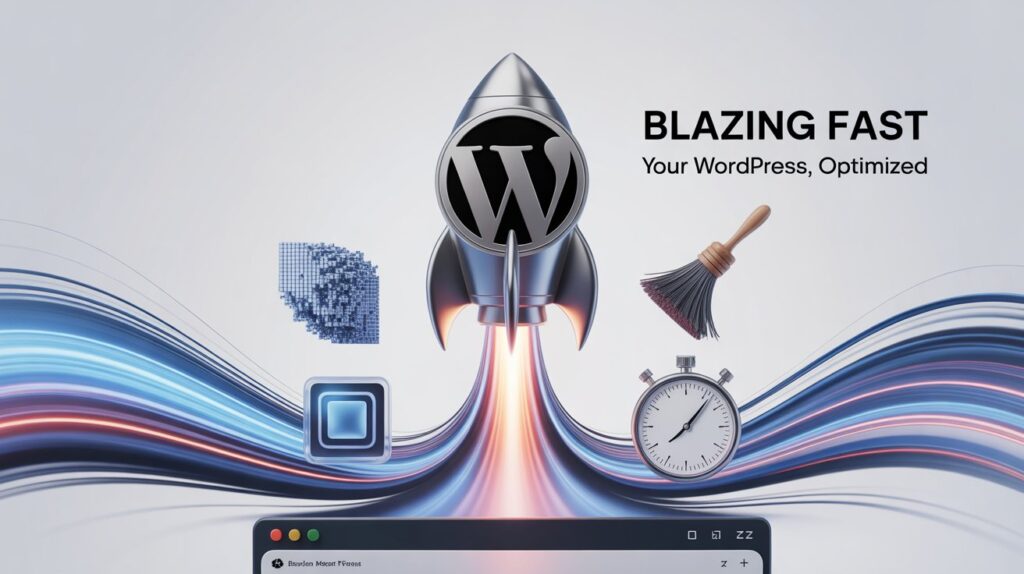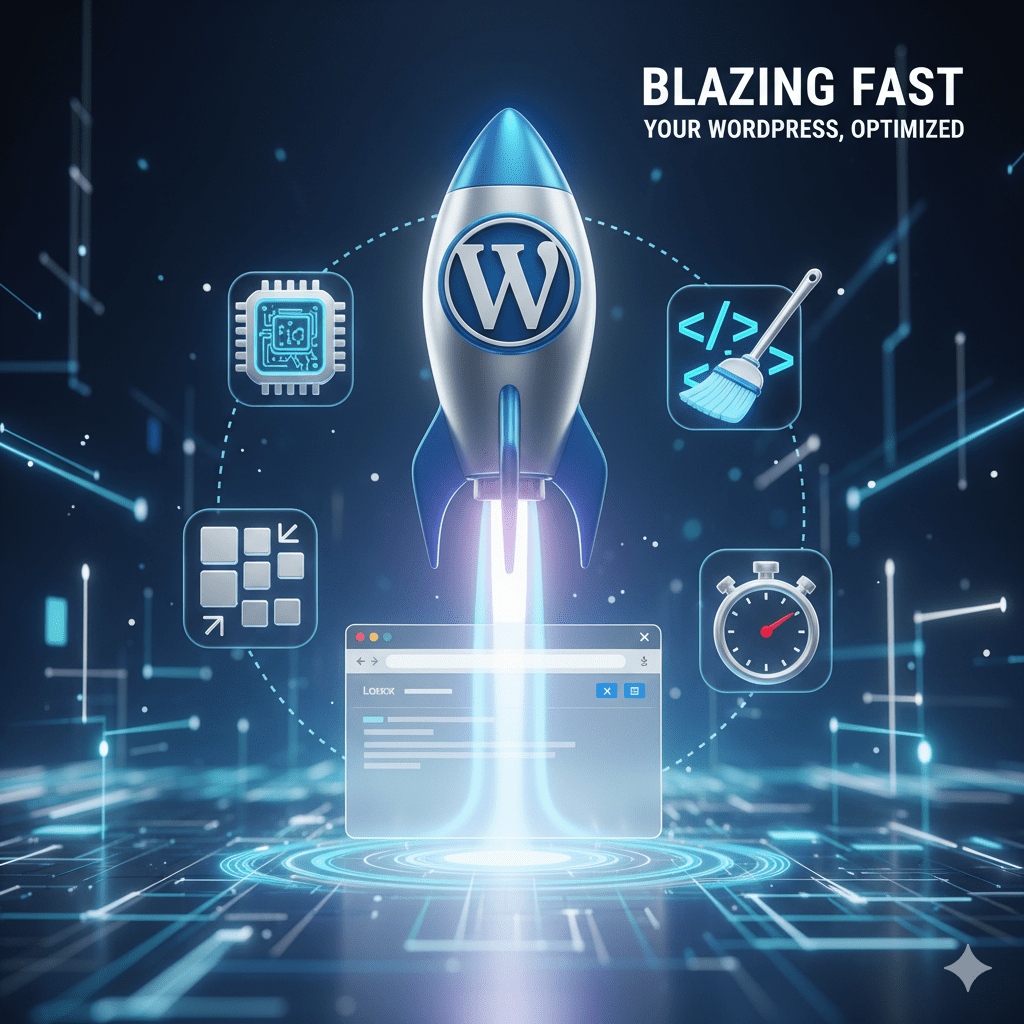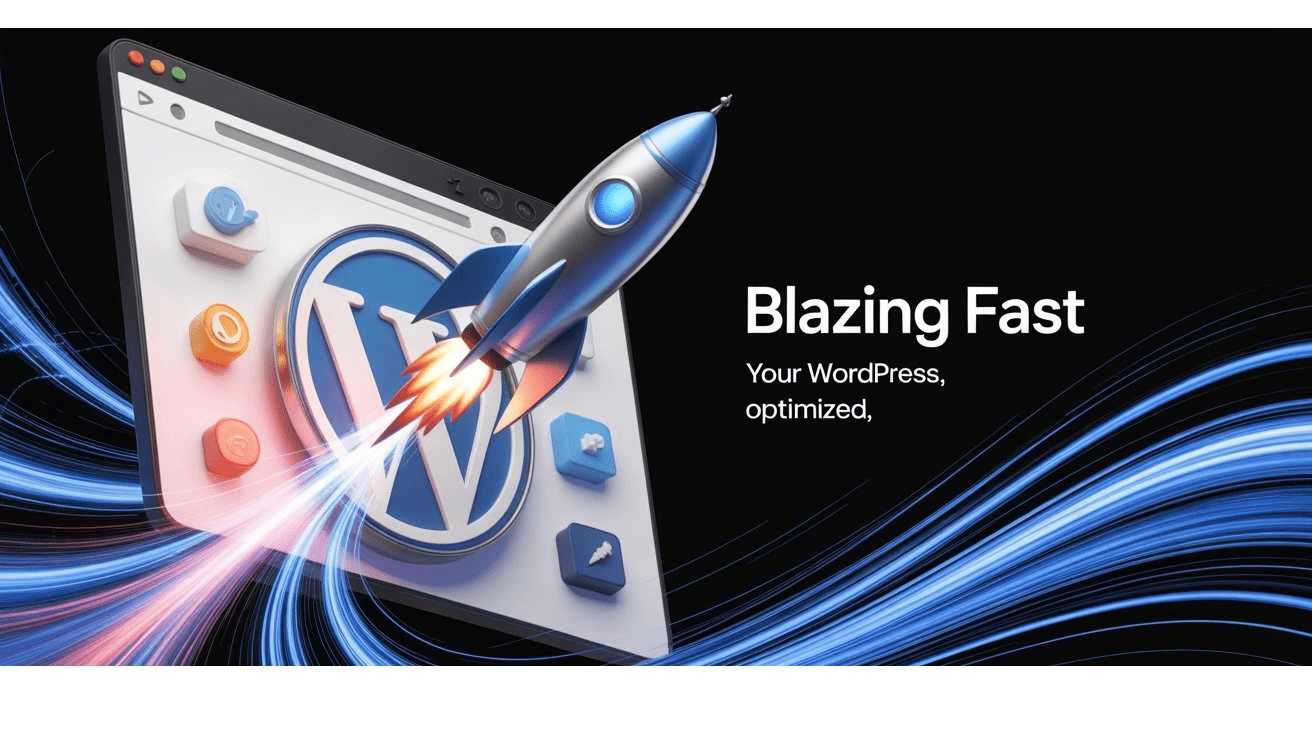Table of Contents
Tired of slow loading times? Losing potential clients because your website feels sluggish? As a Web Designer and Web Developer, I know firsthand how critical website speed is. It’s not just about a better user experience—it’s about improving your SEO, boosting conversions, and making Google’s Core Web Vitals happy. You don’t need to spend a single dollar to achieve blazing-fast performance. I’ve put together a list of the 𝟭𝟬 𝗺𝗼𝘀𝘁 𝗽𝗼𝘄𝗲𝗿𝗳𝘂𝗹, completely free WordPress plugins that will optimize your site’s speed without any cost. Ready to transform your website?

Why Website Speed Matters More Than Ever
In today’s fast-paced digital world, patience is a virtue few possess, especially when it comes to websites. If your site takes more than a few seconds to load, visitors are likely to hit the back button, costing you potential customers, readers, or clients.
User Experience (UX)
A fast website provides a seamless and enjoyable experience for your visitors. They can navigate through your content effortlessly, find what they’re looking for quickly, and are more likely to stay longer and interact with your site. Conversely, a slow site leads to frustration and a poor impression, making visitors less likely to return.

Search Engine Optimization (SEO)
Google, the dominant search engine, openly states that page speed is a significant ranking factor. Faster websites tend to rank higher in search results, increasing your visibility and organic traffic. Google’s Core Web Vitals, a set of metrics measuring real-world user experience, put an even stronger emphasis on speed and responsiveness. Ignoring these can severely impact your SEO efforts.
Conversion Rates
Whether you run an e-commerce store, a service-based business, or a blog, faster loading times directly correlate with higher conversion rates. Studies show that even a one-second delay in page response can lead to a significant drop in conversions. People are more inclined to complete a purchase, fill out a form, or subscribe to a newsletter on a site that feels snappy and efficient.
Cost Savings
Believe it or not, a slow website can also cost you money in hosting fees. If your server is constantly bogged down by unoptimized requests, you might need to upgrade your hosting plan unnecessarily. Optimizing your site with these free plugins can reduce server load, allowing you to get more out of your current hosting environment.
The Power of WordPress Plugins
WordPress is incredibly versatile, and one of its greatest strengths lies in its vast ecosystem of plugins. These small pieces of software extend your site’s functionality without requiring you to write a single line of code. For performance optimization, plugins are indispensable. They automate complex tasks like caching, image compression, and code minification, making it accessible for anyone, regardless of technical expertise, to speed up their site.
The Top 10 FREE WordPress Plugins You NEED to Speed Up Your Site
Let’s dive into the plugins that will transform your sluggish site into a speed demon!
1. Smush – Lazy Load Images, Optimize & Compress Images
Images are often the heaviest elements on any website. High-resolution photos look great but can drastically slow down your loading times. Smush is a lifesaver for image optimization! It compresses and resizes your images, which are often the largest files on a website, without a noticeable loss in quality. It also offers lazy loading, which means images only load when a user scrolls down to see them, saving initial bandwidth. A must-have for every site!
Key Features:
- Lossless image compression
- Resize images to fit specific dimensions
- Lazy Load images
- Bulk Smush existing images
- Integrates with Gutenberg blocks
Download Link: https://wordpress.org/plugins/wp-smushit/
2. WP Fastest Cache
Caching is one of the most effective ways to speed up a WordPress site. When someone visits your site, WordPress dynamically generates the page from its database and theme files. Caching plugins save a static HTML version of your page. The next time a visitor comes, the server simply delivers this ready-made HTML file, which is much faster. WP Fastest Cache is a fantastic and user-friendly caching plugin. It creates static HTML files from your dynamic WordPress site, drastically reducing server load and making your site load much faster for returning visitors.
Key Features:
- One-click installation
- Creates static HTML files
- Minify HTML and CSS
- Combine CSS and JS files
- Browser Caching
Download Link: https://wordpress.org/plugins/wp-fastest-cache/
3. Autoptimize
Beyond caching, optimizing your site’s code is crucial. Autoptimize aggregates, minifies, and caches scripts and styles. This means it combines multiple CSS files into one, multiple JavaScript files into one, and removes unnecessary characters from the code (minification). This significantly reduces the number of HTTP requests your server has to make and the file sizes, leading to faster loading. It cleans up your code and optimizes your site’s loading sequence, improving performance and Core Web Vitals with just a few clicks.
Key Features:
- Aggregates and minifies HTML, CSS, and JavaScript
- Injects CSS in the page header by default
- Moves scripts to the footer
- Optimizes Google Fonts
- Image optimization integration
Download Link: https://wordpress.org/plugins/autoptimize/
4. Async JavaScript
JavaScript files often block the rendering of your web page, meaning content can’t be displayed until these scripts are fully loaded. This creates a perceived delay for users. Async JavaScript is a simple but powerful plugin that allows you to defer or asynchronously load JavaScript files. “Defer” means the script will execute after the HTML document has been parsed, while “async” means the script will execute at the first opportunity once it has been downloaded, without blocking the HTML parser. This prevents render-blocking, ensuring your site’s content appears on the screen much faster.
Key Features:
- Easily add
asyncordeferattributes to JavaScript files - Control which scripts are affected
- Improve render-blocking issues
- Boosts PageSpeed Insights scores
Download Link: https://wordpress.com/plugins/async-javascript
5. LiteSpeed Cache
If your hosting provider uses LiteSpeed web servers (many do, especially with popular hosts), then the LiteSpeed Cache plugin is an absolute game-changer. This isn’t just a caching plugin; it’s an all-in-one optimization suite that leverages the power of the LiteSpeed server at a deeper level than other plugins can. It offers server-level caching, image optimization, CSS/JS minification, database optimization, and much more for unparalleled speed. If you’re on LiteSpeed hosting, this is a non-negotiable install.
Key Features:
- Exclusive server-level cache (LSCache)
- Image Optimization (Lossless/Lossy)
- Minify CSS, JavaScript, and HTML
- Combine CSS/JS
- Lazy Load Images/Iframes
- Browser Cache
- CDN Support
Download Link: https://wordpress.org/plugins/litespeed-cache/
6. EWWW Image Optimizer
While Smush is excellent, EWWW Image Optimizer is another fantastic alternative or complementary plugin for image compression. It automatically optimizes your images as you upload them, ensuring every new image is perfectly sized for the web. It can also convert images to the best file format (like WebP, which offers superior compression without quality loss) and can even optimize previously uploaded images in bulk. It works on your own server, meaning no third-party services are involved in the free tier.
Key Features:
- Automatic optimization on upload
- Bulk optimize existing images
- Convert to WebP (requires a free API key)
- No speed limits and unlimited file size
- Works with popular gallery plugins
Download Link: https://wordpress.org/plugins/ewww-image-optimizer/
7. Lazy Load – Optimize Images (a3 Lazy Load)
Lazy loading is a powerful technique for improving initial page load times. Instead of loading all images and videos at once, lazy loading only loads media content when it becomes visible in the user’s viewport (i.e., when they scroll down to it). The “Lazy Load – Optimize Images” plugin by a3 is perfect for long pages with lots of visual content, saving bandwidth and initial load time. This means your visitors see the top of your page much faster, and resources are only used for content they actually view.
Key Features:
- Lazy loads images, videos, and iframes
- Supports post content, thumbnails, gravatars, and more
- Customizable lazy loading effects
- Integrates with popular plugins
Download Link: https://wordpress.org/plugins/a3-lazy-load/
8. Query Monitor
This plugin is a bit different from the others. While not a direct speed-up tool, Query Monitor is absolutely essential for understanding why your site might be slow. It’s a developer-friendly tool that helps you debug database queries, PHP errors, HTTP API calls, and slow plugin/theme functions that might be bogging down your site. Think of it as a diagnostic tool. By identifying the bottlenecks, you can take targeted action to fix them. It’s an invaluable asset for anyone serious about performance.
Key Features:
- Shows database queries, errors, hooks, and more
- Displays HTTP API calls
- Highlights slow queries
- Provides information about script and style dependencies
- Offers insights into server environment
Download Link: https://wordpress.org/plugins/query-monitor/
9. Heartbeat Control
The WordPress Heartbeat API is a fantastic feature that enables real-time communication between your browser and your server. It’s used by WordPress for things like auto-saving posts, showing which users are currently editing a post, and displaying real-time sales in WooCommerce. However, this constant communication can consume significant server resources, especially on busy sites or shared hosting. Heartbeat Control lets you manage and control the frequency of this API, which can dramatically reduce CPU usage and improve your site’s overall performance without breaking essential functionalities.
Key Features:
- Control Heartbeat API frequency in different areas (dashboard, frontend, post editor)
- Disable Heartbeat API in specific areas
- Reduce CPU and resource usage
- Improve server response times
Download Link: https://wordpress.org/plugins/dynamic-front-end-heartbeat-control/
10. Imagify
Imagify, like Smush and EWWW, is a powerful image optimization service. While it has premium tiers, its free tier is generous enough for many smaller sites. It resizes, compresses, and converts images to the WebP format, offering robust optimization capabilities. It’s powerful, easy to use, and a surefire way to speed up your site by making your images lighter without compromising visual quality. It can significantly reduce image file sizes and improve page load times.
Key Features:
- Optimizes images with three compression levels (Normal, Aggressive, Ultra)
- Converts images to WebP format
- Resizes images on the fly
- Bulk optimization
- Restores original images
Download Link: https://wordpress.org/plugins/imagify/
How to Get Started with These Plugins
- Backup Your Site: Before installing any new plugins, always create a full backup of your WordPress site. This way, if anything goes wrong, you can easily restore your site.
- Install One by One: Don’t install all 10 at once. Install one plugin, configure it, test your site’s speed (using tools like GTmetrix or Google PageSpeed Insights), and then move on to the next. This helps you identify if a specific plugin causes any conflicts.
- Read the Documentation: While most of these plugins are user-friendly, take a few minutes to read their official documentation or watch tutorial videos. Understanding their settings will help you get the most out of them.
- Monitor Your Speed: Regularly check your website’s performance using online tools. This will help you see the impact of each plugin and ensure your optimizations are working.
Final Thoughts
You don’t need a massive budget to have a lightning-fast WordPress website. By strategically using these free, powerful plugins, you can significantly improve your site’s loading speed, enhance user experience, boost your SEO, and ultimately drive more conversions. Take the time to implement these solutions, and you’ll be amazed at the difference they make. Happy optimizing!
FAQs
Q1. Why is website speed important for my WordPress site?
A: Website speed is crucial for user experience, SEO rankings (Google prioritizes fast sites), and conversion rates. Slow sites lead to high bounce rates and negatively impact your online presence.
Q2. Can I really speed up my WordPress site without spending money?
A: Absolutely! This blog post highlights 10 free WordPress plugins that offer powerful optimization features like caching, image compression, and code minification, all without any cost.
Q3. What are Core Web Vitals and how do they relate to website speed?
A: Core Web Vitals are a set of metrics from Google that measure real-world user experience, including loading performance (Largest Contentful Paint), interactivity (First Input Delay), and visual stability (Cumulative Layout Shift). Optimizing your site’s speed directly improves these vital scores.
Q4. Do I need all 10 plugins mentioned in the list?
A: While all plugins offer great benefits, you might not need every single one. For instance, you typically only need one primary caching plugin (like WP Fastest Cache or LiteSpeed Cache). It’s best to identify your site’s specific bottlenecks using tools like GTmetrix and then select plugins that address those issues.
Q5. Will installing too many plugins slow down my WordPress site?
A: Not necessarily. The quality of plugins matters more than the quantity. Well-coded, efficient plugins won’t significantly impact performance. However, poorly coded or redundant plugins can cause conflicts or slow down your site. Always test performance after installing new plugins.
Q6: What should I do before installing any new optimization plugins?
A: Always perform a full backup of your WordPress website before installing any new plugins, especially those that modify core site functionality. This ensures you can restore your site if any issues arise.
Q7: How often should I check my website’s speed after implementing these plugins?
A: It’s good practice to check your website’s speed regularly, perhaps once a month or after any major content updates or plugin installations. Tools like GTmetrix and Google PageSpeed Insights can help you monitor your performance over time.


